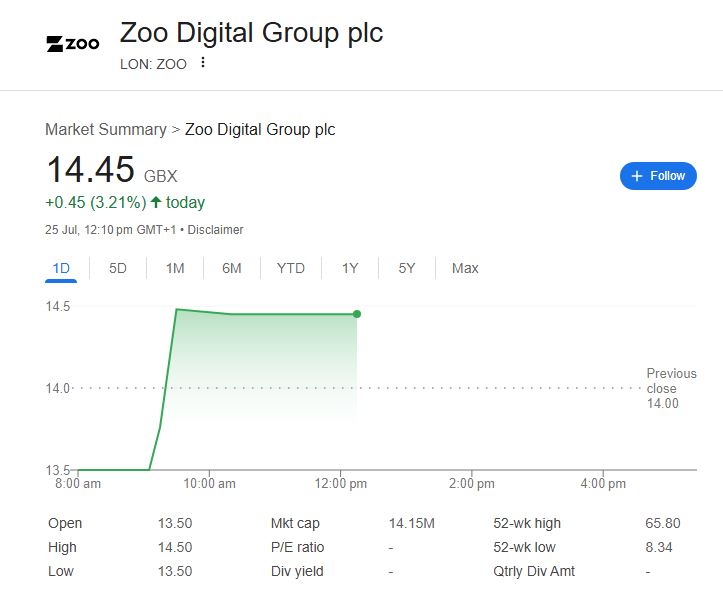The share price of Zoo Digital has shown an amazing pattern of volatility in recent months, rising steadily from a low of 8.34 GBX in April to 14.45 GBX by the end of July. For speculative investors who saw potential despite the company’s run of quarterly losses, this comeback has been especially helpful. This most recent increase is encouraging because it reflects a broader cautious optimism among shareholders, particularly as the streaming industry shifts to multilingual, localized content strategies.
Zoo Digital has established itself as a crucial partner in the worldwide distribution of content by concentrating on dubbing, subtitling, and closed captioning services. The company’s distributed infrastructure, which spans from Los Angeles to Dubai, allows it to access thousands of independent translators and voice actors, giving it great flexibility in responding to local market demands. This model has proven especially helpful to Netflix, Amazon, and Disney as they strive to increase viewership in non-English speaking regions.
Zoo Digital Group plc – At a Glance
| Company Name | Zoo Digital Group plc |
|---|---|
| Stock Ticker | LON: ZOO |
| Industry | Software—Media Localization |
| Headquarters | Sheffield, United Kingdom |
| Founded | 2001 |
| CEO | Dr. Stuart Green |
| Employees | 515 (2024) |
| Share Price (25 Jul) | 14.45 GBX |
| Market Cap | £14.15M |
| 52-Week High | 65.80 GBX (19 Aug 2024) |
| 52-Week Low | 8.34 GBX (8 Apr 2025) |
| Revenue (TTM) | £46.78M |
| Net Income (TTM) | -£14.31M |
Even with significant revenue increases—up almost 29% year over year—the business is still losing money. Zoo’s bottom line still needs a lot of work, as evidenced by its net income of £1.31 million last quarter. Investors are still interested, though. Compared to the FTSE 100’s modest 11.18% return, one-year returns have soared by 77.42%. This kind of surge indicates a growing confidence in Zoo’s long-term viability and is remarkably similar to other high-risk, high-reward tech plays.
In the past, Zoo has demonstrated a talent for creativity. The business received recognition for its award-winning interactive software and DVDs in its early years. By 2005, it had created DVD EXTRA Studio, a popular authoring tool. It had signed long-term software deals with Sony and Disney by 2008. These technologically driven strategic victories prepared the way for its current shift to cloud-based media localization.
The need for localization increased during the pandemic, when streaming emerged as the primary source of entertainment. Despite being in a position to profit, Zoo’s balance sheet didn’t show it. Investors became cautious, losses widened, and competition grew fiercer. The share price has, however, significantly increased since the low point in April 2025, indicating that the market is starting to reconsider its initial skepticism.
Zoo has started to streamline operations and free up creative talent to concentrate on voice quality and cultural nuance—elements crucial for maintaining authenticity in dubbed content—by incorporating more automation into its localization workflow. This strategy has proven incredibly successful in drawing in media clients who require accuracy and speed. Although the efficiency improvements have not yet resulted in net profits, they do point to a more future-proof and scalable model.
A variety of forecasts have been made by public market analysts. A 12-month target price of 73.09 GBX, which would be more than 400% higher than current levels, was recently floated in a bullish report. Although ambitious, that prediction depends on Zoo securing additional studio deals or even being pursued for acquisition, which is not wholly unrealistic considering its history and technological advantages.
The price of Zoo Digital shares is a challenge and an opportunity for early-stage investors. On the one hand, its return on equity is a depressing -42.97%, and its PE ratio is undefinable because of its negative earnings. However, it is especially appealing for risk-tolerant portfolios due to its robust revenue pipeline and low price-to-sales ratio of 0.41.
By using strategic positioning, Zoo keeps growing its footprint in areas with the fastest growth in streaming, especially in the Middle East, Southeast Asia, and Latin America. It can provide broadcasters with extremely effective localization workflows by utilizing cloud infrastructure, frequently more quickly than its conventional rivals. In the upcoming quarters, this ability might be the differentiator that helps Zoo achieve long-term profitability.
Content producers are advocating for more accessible formats in light of the growing demand for inclusive entertainment. According to Oscar-winning filmmaker Bong Joon-ho, “you will be introduced to so many more amazing films once you overcome the one-inch tall barrier of subtitles.” Businesses like Zoo, who make overcoming that “barrier” easy, benefit from this mentality change.
Despite past financial setbacks, Zoo Digital has remained relevant by working with international studios and utilizing AI-driven automation tools. In a market where customers value end-to-end convenience, its software platform is incredibly resilient because it now supports end-to-end localization, including automated subtitle timing and voice-over management.
The ability of Zoo’s leadership to convert technical excellence into shareholder value will be the main concern for investors in the upcoming months. Despite growing much more quickly than many of its rivals, its share price is still unstable. However, Zoo Digital may prove to be a vital resource in the globalization of content as streaming behemoths continue to reduce expenses and outsource specialized services.



